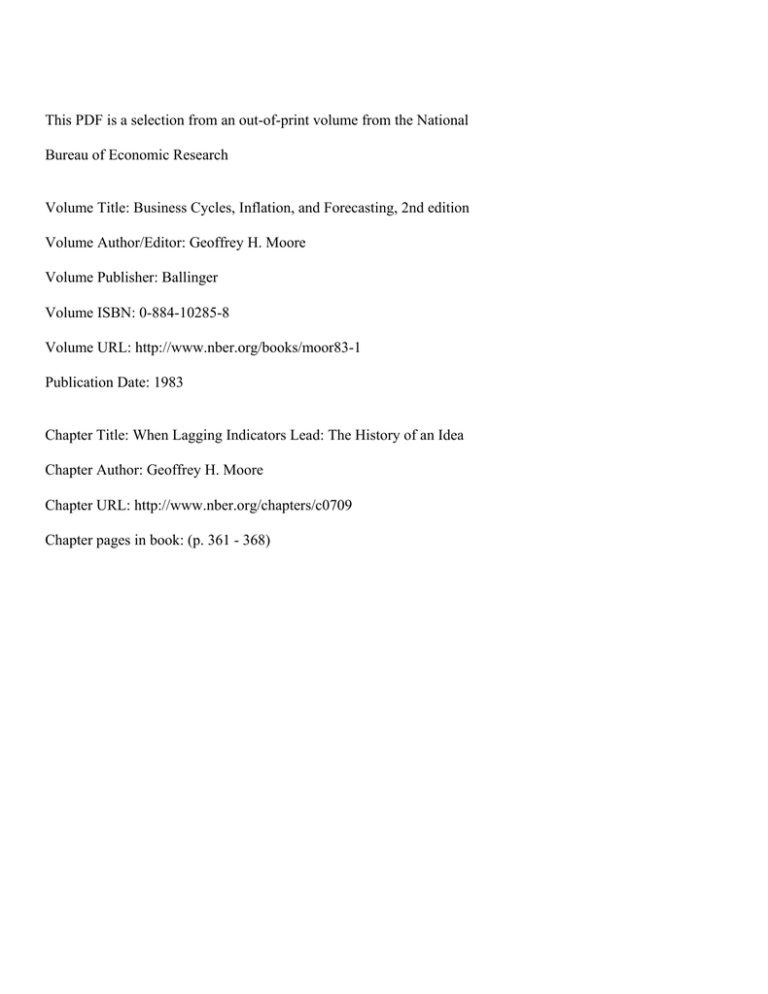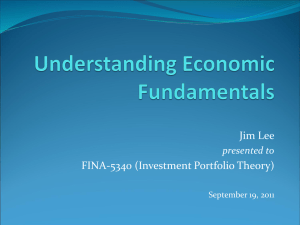When Lagging Indicators Lead: The History of an Idea
advertisement

This PDF is a selection from an out-of-print volume from the National Bureau of Economic Research Volume Title: Business Cycles, Inflation, and Forecasting, 2nd edition Volume Author/Editor: Geoffrey H. Moore Volume Publisher: Ballinger Volume ISBN: 0-884-10285-8 Volume URL: http://www.nber.org/books/moor83-1 Publication Date: 1983 Chapter Title: When Lagging Indicators Lead: The History of an Idea Chapter Author: Geoffrey H. Moore Chapter URL: http://www.nber.org/chapters/c0709 Chapter pages in book: (p. 361 - 368) em- job Chapter 23 tion been When Lagging Indicators Lead: The History of an Idea Data or a iVail- iame oto e of connber pro- yee payfracfiniiping reli- hose iness total !busi- allinin the ber of unng nd IS more iading On Tuesday, February 14, 1978, the Wall Street Journal ran a front page news story on the "lagging indicators." It was a high water mark in terms of public interest in these series after four decades of relative neglect. Attention is usually riveted on the leading indicators. Who cares about the followers? The leaders tell us where we're going. This view is understandable and is fostered by the terms used to classify the indicators. Nevertheless it is unfortunate because it neglects the problem of who or what it is that tells the leaders where to go. We live in an interdependent world, and the business cycle is one of the manifestations of that interdependence. A downturn in a leading indicator—say an index of stock prices—is not the beginning. It is a result of something else. The something else is where the lagging indicators áome in. This idea has had a long history. My first acquaintance with it began when I read Mitchell and Burns's "Statistical Indicators of Cyclical Revivals" in 1938. In that study some seventy economic series were arrayed according to the length of their average lead or lag at business cycle troughs. Several series on bond yields were placed at both the top and the bottom of the list. The authors explained that bond yields, as well as some other series, could be con- sidered either to conform positively to business cycles, in which case their upturns generally lagged behind the revival in business, or to Reprinted from the NBER Reporter, Winter 1978. This chapter also appeared in the New York Statistician (New York Area Chapter of the American Statistical Association), March-June 1978. 361 I 4 362 Forecasting I conform inversely, in which case their downturns generally preceded decisio interest rates up as demand for loans expanded arid pressure on reserves mounted. But the prior decline in interest rates facilitated revival by reducing costs of borrowing and indicating that credit was easier to get. From one point of view, bond yields were a lagging indicator of revival; from the other point of view, a leading indicator. In my 1950 paper, "Statistical Indicators of Cyclical Revivals and Recessions," I pushed this idea a bit further by showing that it applied to both recessions and revivals and that it applied to the entire group of indicators that I classified as lagging. Tracing the record rate of the revival in business. After a while,, a business revival tended to pull back to 1885, I noted that the downturns in the laggers had consistently preceded the upturns in the leaders, while upturns in the laggers had consistently preceded downturns in the leaders. Considered on an inverted basis, the laggers were the longest of leaders. The lengths of their leads varied from one business cycle to another, but these variations were positively correlated with those in the leads of the leading indicators. Such consistency over a fifty year period bespoke a causal connection. Subsequent studies of the indicators revealed that this relationship had persisted. In 1969 I wrote "Generating Leading Indicators from Lagging Indicators" in an effort to put more meat on the bones of the argument. I noted that there were good economic reasons to expect that rapid increases in certain types of lagging indicators— interest rates, costs of production, inventories, and outstanding debt—would have deterrent effects on certain types of leading indicators—new commitments to invest, profit margins, inventory accumulation, new credit extensions, and so forth. One way to determine what was a "rapid increase" was to compare the increase in the lag- gers with that in the coincident indicators, since the latter represented the rate of growth in aggregate economic activity. The ratio of coincident to lagging indicators quantified this comparison. Sev- eral such ratios, notably the ratio of sales to inventories, already existed and behaved in the expected manner.' Phillip Cagan contributed a useful study on this theme in 1969, "The Influence of Interest Rates on the Duration of Business Cycles." He showed that the lengths of the lags in interest rates after business cycle turns had a bearing upon the length of the business expansion or contraction in which they occurred. A delayed upturn in rates indicated a long expansion, and a delayed downturn indicated a long contraction. He also pointed out that this connection may operate through the relation between interest rates and the money supply and through the effect of interest rate changes upon pôthesi comme In 1 her fat countri as they of Eco she fou not onl WestG in all t at the notnic treated Vict cators ratio o Busine 1976.1 Nation showe the lea 1948— Associ strated to exte forecas The Digest betwee on the lagging can be twelve (see T sistenti entire gest a long b to the 1 tative ii When Lagging Indicators Lead: The History of an Idea 363 1 decisions eceded to pull on re. ilitated dit was alsand t it ap- entire record ad con- rate of change in the money supply and contracts for residential, J I I inthe onsid- I [rs. The od beonship L from nes of ions to ators — anding g mdi - accu?rmine he lagrepre- . ratio Sev- iready 1969, s Cyafter iness pturn mdi?ction d the upon commercial, and industrial construction. In 1971 my daughter, Kathleen Moore (with a little nudge from her father), took up the question. Do lagging indicators in other countries display the same properties vis-à-vis the leading indicators as they do in the United States? In "The Comparative Performance of Economic Indicators for the United States, Canada, and Japan," she found that they did. Philip Klein and I followed this with studies not only for Canada and Japan, but also the United Kingdom and West Germany. We found the relationship substantially confirmed in all these countries.2 The British in their own work on indicators at the Central Statistical Office, now published regularly in Economic Trends, also find that interest rates and unit labor costs, treated invertedly, behave as leading indicators. er, but leads of to invest. He developed evidence that supported this hy. pothesis by examining the behavior of such leading indicators as the I Victor Zarnowitz and Charlotte Boschan, in their study of indifor the Bureau of Economic Analysis, recommended that the ratio of the coincident to lagging indexes be regularly published in Business Conditions Digest. This has been done since November 1976. In the Fifty-Seventh Annual Report (September 1977) of the National Bureau of Economic Research, Zarnowitz and Boschan showed how the lagging index (treated invertedly) consistently led the leading index in an analysis of growth cycles during the period 1948—1975. In a paper presented before the American Statistical cators Association in August 1977, Zarnowitz and Beatrice Vaccara demon- strated that the lagging indicators (treated invertedly) could be used to extend the forecast span of the leading indicators in quantitative forecasts of real GNP and other coincident indicators. The new list of indicators that is now used in Business Conditions Digest enables us to update the historical record on the relationship between cyclical turns in the leading and lagging indicators. The table on the median leads and lags of seventy-five leading series and thirty lagging series in my 1950 paper that covered the period 1885—1938 can be extended from 1948 to 1975 by using the medians for the twelve leading series and six lagging series in the BCD list. The results (see Table 23-1) show that the turns in the lagging group have persistently preceded the opposite turns in the leading group during the entire ninety year period. Usually the turns are close enough to suggest a plausible relationship. The exceptions pertain to the unusually long business cycle expansions ending in 1937, 1953, and 1969 and to the long contraction ending in 1933. Apart from these unrepresentative instances, the median upturn in the lagging group has preceded 364 Forecasting Table 23-1. Cyclical Timing of Leading and Lagging Indicators, 1885—1975. Lead (—) or Lag (+) in Months at Business Cycle Peak Business Cycle Peak March 1887 July 1890 January 1893 December 1895 June 1899 September1902 May1907 January1910 January1913 August1918 January 1920 May1923 October1926 June1929 May1937 February 1945 November 1948 July1953 August 1957 April 1960 December 1969 November1973 Median Trough, Lagging Group Median Peak, Leading Group —20 —14 —8 —14 —6 —15 —27 —11 —14 —34 —9 —13 —24 —15 —50 n.a. —3 —5 —5 —5 —1 —4 —16 —4 —3 —20 —2 —4 —11 —5 —2 —39 —31 —19 —99 —24 —5 n.a. na. —10 —21 —12 in Months (trough in lagging to peak in leading) Busin Cycle T May 18 April 18 17 9 3 May 18 June 18 June 18 Decem 9 5 11 9 August June 19 January 7 11 14 Decemi April 1 7 July 19 July 19 9 13 10 48 Novem March June 1 n.a. n.a. 34 10 Octobe Octobe May 19 —9 —8 90 16 April 1 Februa Novem March —24 —7 17 Averag —18 —8 10 Averages: All observations Excluding 1937, 1953, 1969 Table 2 In terual 7 AM Excluc Note: na., data not available. Sources: 1885—1938: Geoffrey H. Moore, "Statistical Indicators of Cyclical Revivals and Recessions," Occasional Paper 31 (New York: NBER, 1950), Table 11. Based on seventy-five leading and thirty lagging series. 1948-1975: Business Conditions Digest, October 1977, Appendix F. Based on twelve leading and six lagging series. —4 When Lagging Indicators Lead: The History of an Idea 365 35—1975. Table 23-1. continued Tnterual iMonths Lead (—) or Lag (+) in Months rough in gging to peak in ieading) at Business Cycle Trough Business Cycle Trough May 1885 April 1888 May 1891 June 1894 June 1897 December 1900 17 9 3 9 5 11 August1904 9 7 June1908 11 14 7 9 13 48 n.a. 10 7 90 16 —8 —9 —6 July1921 —12 —1 —3 —5 July1924 —10 —6 —13 na. 5 1 7 4 3 0 0 4 13 4 7 4 —4 —5 —4 10 38 —6 —6 —5 —9 —4 —5 —6 —2 —2 —2 —1 6 0 4 3 —11 5 6 —9 —5 5 —14 —43 —10 n.a. —11 n.a. 6 n.a. 7 3 Averages: 17 All observations 10 Excluding 1933 Cyclical ), Table Based L —11 —13 —7 October 1945 October 1949 May1954 April1958 February 1961 November 1970 March1975 34 —5 —6 —2 —4 —4 —9 —5 —9 —6 —17 —14 June1938 n.a. n.a. —7 Median Trough Leading Group January 1912 December1914 April1919 November1927 March 1933 10 Median Peak, Lagging Group Interval in Months (peak in lagging to trough in leading) j 366 Forecasting median downturn in the leading group by ten months on the average, while the median downturn in the lagging group has preceded the median upturn in the leading group by an average of five months. The record since 1948 does not seem to differ greatly from REFERE the Cagan, Cycles." I vol. 1,pp. that prior to 1938. Long leads in the inverted lagging group, relative to the business cycle, are associated with long leads in the leading Centrá nOTflZC Tn Lempe Mérria group, and vice versa.3 All this is relevant in 1978 because of recent advances in the lagging indicators, and this was the reason for the Wall Street Journal story. BCD '5 lagging index began rising more rapidly than the coincident index after April 1977, and hence the coincident to lagging ratio declined.4 The leading index, meanwhile, continued to rise, but not so vigorously as the lagging index. The question in the summer of 1978, therefore, was how long the upward trend in the leading index would persist in the face of factors that over many years have foreshadowed its decline. 1887—1938 •N 1937,1953,1969) Cycle In 1951. Moot 1. So far as I know, Edgar Fiedler, then at Bankers Trust Company, was the first to compute a ratio based upon composite indexes of coincident and lagging indicators. He did this in 1964 to test the view expressed by Leonard Lempert (1964) that cyclical imbalance should be measured by comparing the rates of increase in the laggers with those in the coincident. Another early (1968) experimenter with such ratios was John H. Merriam of Idaho University. 2. See Chapter 6 in this book. 3. The correlation coefficients (r) between the leads of the inverted lagging group and those of the leading group in the table are as follows: Omitting four long phases (ending 1933, • • Mitch Revivals.' Cycle Inc Moore sions." C Econom NOTES TO CHAPTER 23 All observations June 196 r 1948—1975 N r 1887—1975 r N 30 +0.33 11 +0.38 41 +0.35 23 +0.76 9 +0.90 37 +0.81 4. Edgar Fiedler recently observed that since two of the six lagging indicators included in the lagging index are expressed in current dollars, it is more affected by inflation than the coincident index whose four components are all expressed in physical units or in constant dollars. To rectify this, the two lagging mdi. cators—unit labor cost and commercial and industrial bank loans—could be deflated by using man hours per unit of output (the reciprocal of the usual productivity measure) as the physical counterpart of unit labor cost and deflating loans by the wholesale price index for industrial commodities. Home n Mooi cators f Decemt Vace Indicat Americ Zart Coinci ment 0 NBER, When Lagging Indicators Lead: The History of an Idea 367 the as preof five y from elative on leading he lag- Tournal e coin- 'lagging o rise e sum e " eayears 1 REFERENCES Cagan, Phillip. "The Influence of Interest Rates on the Duration of Business Cycles." In Essays on Interest Rates, ed. Jack M. Guttentag and Phillip Cagan, vol. 1, pp. 3—28. New York: NBER, 1969. Central Statistical Office. "Cyclical Indicators for the U.K. Economy." Economic Trends 257 (March 1975): 95—109. Lempert, Leonard H. Statistical Indicator Associates, September 16, 1964. Merriam, John H. "New Economic Indicators." Western Economic Journal, June 1968, pp. 195—204. Mitchell, Wesley C., and Arthur F. Burns. "Statistical Indicators of Cyclical Revivals." New York: NBER. Bulletin 69, May 28, 1938, Reprinted in Business Cycle Indicators, ed. Geoffrey H. Moore, pp. 162—83. New York: NBER, 1961. Moore, Geoffrey H. "Statistical Indicators of Cyclical Revivals and Reces. sions." Occasional Paper 31. New York: NBER, 1950. Reprinted in Business Cycle Indicators, 1951. ed. Geoffrey H. Moore, pp. 184—260. New York: NBER, "Generating Leading Indicators from Lagging Indicators." Western Economic Journal, June 1969, pp. 137—44. Moore, Geoffrey H., and Philip A. Klein. was the lagging empert rates of 168) ex• Business Cycles at Moore, Kathleen Harriet. "The Comparative Performance of Economic mdi. cators for the United States, Canada, and Japan." Western Economic Journal, December 1971, pp. 419—27. Vaccara, Beatrice N., and Victor Zarnowitz. "How Good Are the Leading Indicators?" 1977 Proceedings of the Business and Economic Statistics Section. American Statistical Association, 1978. Zarnowitz, Victor, and Charlotte Boschan. "New Composite Indexes of lagging Coincident and Lagging Indicators." Business Conditions Digest. (U.S. Depart. ment of Commerce), I"Jovember 1975. 975 NBER, September 1977. p.35 0.81 icators rfected ressed g mdibe usual iild pd I Monitoring Home and Abroad. New York: NBER, forthcoming. de- "Cyclical Indicators." Fifty-Seventh Annual Report. New York: r I SUM Fort brief that busir genei econ inves its p tors, Sinc their Oi form used com man the I was i TF the i contS the 1 Repr (Wasi

